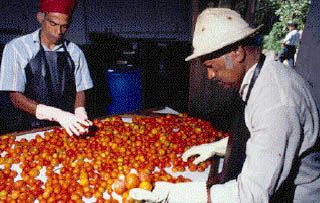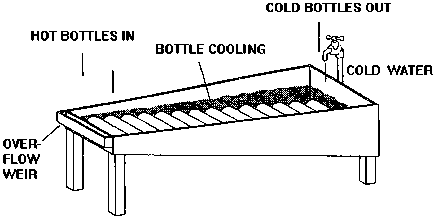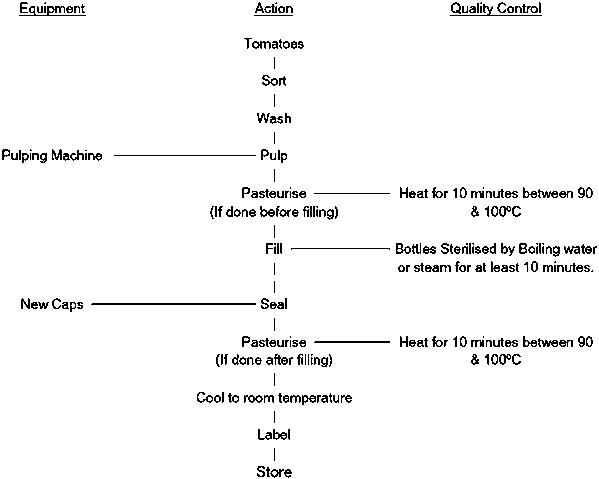How to Preserve Tomato
Contents
Short Description
- Problem:
- Idea:
- Difficulty:
- Price Range:
- Material Needeed:
- Geographic Area:
- Competencies:
- How Many people?
- How Long does it take?
Tomato Processing - Technical Brief
Technology challenging poverty
Introduction
The demand for tomato processing usually arises from a need to preserve the product for cooking purposes (inclusion in stews, soups, curries etc) out of season or to add value for extra income. Traditionally, the most important methods used are concentration (to a paste or puree) and drying either fruit pieces or to a powder. These remain the most suitable processes for many people to use and form the bulk of this brief. It should be noted that high quality "salad" tomatoes have the highest value when sold fresh and in good condition. These would not normally be used for processing, unless for home use to save excess at the height of the season.
Raw material quality
For each of the processes described below the tomatoes should be ripe, red, firm to soft, free of all mould growth (by cutting out infected parts) and free of stems, leaves, dirt and other soils (by washing). It is less important if the tomatoes have surface blemishes or splits/cracks (provided these are not infected) as in most processes they will be cut or pulped.
Processing
Drying
Traditional methods in hot, dry regions include sun drying. The tomato halves are placed on clean flat surfaces (eg roofs) with the cut side facing up or by threading the halves on to strings and hanging in the sun from a branch or beam. In both cases, drying is relatively rapid (depending on the temperature and humidity of the air) but there may be contamination of the product by insects, dirt and dust, this can be reduced by covering the tomatoes with fine muslin cloth or mosquito netting. The end product is dark, red, leathery pieces with a strong tomato flavour. Re-hydration is relatively slow, but this may be unimportant in cooking applications. Provided that the humidity is low, the dried product will keep without special packaging for several months. If the humidity rises the product will go mouldy and should be protected either by suitable packaging (eg sealed plastic bags - preferably polypropylene or thick polythene, or in sealed pottery jars) or dried slowly over a fire to a low moisture content. The tomatoes should be far enough away from the fire to prevent cooking they will be fully dried when they are hard and brittle.
If the climate is not hot and dry, an artificial drier could be considered but the cost of the drier and fuel should be carefully calculated to see if it is economic to dry this often low value food.
When tomatoes are dried to a low moisture content, so that they are hard (eg 5% water), they can be pounded or milled to a powder. This is more convenient to use and store (eg sealed glass or pottery jars or sealed polypropylene film bags thin polypropylene - the most common type of plastic will not stop moisture entering the product and subsequent mould growth within a few weeks). Layers of pulp can also be dried to a rubbery fruit leather and stored in plastic film. Alternatively the post dried pulp can be formed into balls or cubes and then dried in the sun or over a fire.

Figure 1: Sorting the tomatoes. Processing unit at Walewela, Matale, Sri Lanka.
�Zul/Practical Action
Concentration
Tomato pulp can be prepared using a pestle and mortar, some types of mills (eg "Posho" mill in West Africa) or by small pulping machines. It is usually necessary to remove seeds and skins this can be done by sieving through a medium mesh (eg 1-2mm holes) or, in the case of some of the pulpers, these parts are separated by the machine.
Juice/squash
Tomato juice can be separated from the pulp by filtering but more commonly the entire pulp is used as "juice". This can be preserved by hot water pasteurising in sealed bottles at 90-100�C for at least 10 minutes followed by cooling to room temperature (Figure 2) or by hot filling into sterile bottles. A certain amount of separation of pulp and liquid during storage is inevitable - with pulp accumulating at the bottom of the bottle. However, clear separation into a pale liquid and a solid pulp layer is evidence of under-pasteurisation. This is not likely to be harmful but is less attractive. Some small-scale producers have found that adding 0.3% thickener (eg sodium alginate) completely prevents separation. This is a permitted additive in most countries but may be expensive and is not really necessary.
Tomato squash is tomato pulp with added sugar syrup to give a concentration of 30-50% total solids (�Brix) measured by refractometer. It is not a widespread product as people tend to prefer squashes made from other fruits but it may well be worth investigating in your own area. It is processed in a similar way to juice and may in addition contain up to 100ppm of sodium (or potassium) benzoate preservative in most countries (check with your local Bureau of Standards).
Tomatoes can be boiled to evaporate the water. Depending on how much water is removed and what other ingredients are mixed into the pulp, it is possible to obtain a large number of products. Examples are given in Table 1.
Table 1: Products from tomato pulp
|
|
|
|
|
|
Paste |
|
|
|
|
Puree |
|
|
|
|
Jam |
|
|
(pectin), sugar, (acid) |
|
Chutney |
|
|
vinegar, salt, spices |
|
Ketchup |
|
| |
|
Soup |
|
|
flour, salt, sugar |
* Usually measured by refractometer as �Brix. Figures in brackets are final temperature of boiling at sea level, which is an alternative way of measuring solids content (at higher elevations the boiling point is progressively reduced and separate technical advice is needed if you are above approximately 2000m)
The basic preservation principle behind all of these products is to remove water by boiling to:
a) heat the product to destroy enzymes and micro-organisms and
b) concentrate the product so that contaminating micro-organisms cannot re-grow.
This can be done in an open pan over a fire. It is necessary to heat slowly - especially when the product is more concentrated - to prevent it burning onto the pan. It should also be stirred continuously which is very labour intensive (and hot work). The product will be a dark red paste with a strong taste of tomato.
A better colour and faster process can be achieved using a steam jacketed boiling pan with steam from a boiler but this is expensive and should only be considered for larger scales of operation. The bright red colour of imported tomato pastes and purees can only be obtained by using vacuum evaporators and at present there is no low-cost small-scale equipment available to our knowledge.
After boiling to the correct solids concentration (usually 65-75� Brix by refractometer or to a temperature of 104-106�C at sea level) the product is filled into pre-sterilised jars (100�C for ten minutes in steam or water) and cooled to room temperature. A selection of typical recipes for each product is given below.
Tomato jam
1kg tomato pulp
1kg sugar
(pectin and citric acid not usually necessary but 0.1% pectin and adjustment to pH3.3 may be needed).
Green tomato chutney
1kg tomatoes
125g cooking apples
500g onions
100g sultanas
450 ml vinegar
500g sugar
1 level teaspoon salt
� level teaspoon mustard
� level teaspoon pepper
2 level teaspoons curry powder
Peel the tomatoes, chop the apples and onions into small pieces. Mix all the ingredients except the sugar and boil gently until soft. Add the sugar and boil for a further 30 minutes. Pour into jars and tie down.
Tomato ketchup for 1kg
420g tomato puree
150g sugar
300g vinegar (10% acetic acid)
300g salt
70g onion pulp
30g (garlic puree and other spices to taste)
Tomato soup for 1kg
60g tomato puree
30g sugar
10g salt
20g flour
20g spices/garlic puree/onion puree etc to taste
860g water (mix ingredients oil fill into pasteurised jars and pasteurise at 90�C for 15 minutes.
References and further reading
This Howtopedia entry was derived from the Practical Action Technical Brief Tomato Processing .
To look at the original document follow this link:
http://www.practicalaction.org/?id=technical_briefs_food_processing
- Semi-processing of Tomatoes, Practical Action Technical Brief
- How to grow tomato and peppers: agrodok 17: M. Amati et al, Agromisa, 1989
- Small-scale Food Processing: A Directory of Equipment & Methods, S. Azam-Ali et al, ITDG Publishing, 2003
- Tomato and Fruit Processing, Preserving and Packaging: An example of a village Factory, Guus de Klein, CIEPAC/TOOL, 1993
Related Articles
- How to Preserve Food with Small Scale Drying Technologies
- How to Preserve Food by Drying
- How to Use Sun Power
- How to Make Chocolate
- How to Preserve Tomato
- How to Preserve Food with a Solar Dryer
- How to Process Spice
- How to Process Turmeric
- How to Build a Tray Dryer
- The Anagi Tray Dryer
- How to Dry Chillies
- How to Process Pepper
Equipment suppliers
Note: This is a selective list of suppliers and does not imply endorsement Practical Action.
DISEG Diseno Industrial y Servicios Generales
Av. Jose Carlos Mariategui
1256 Villa Maria del Triunfo
Lima
Peru
Tel: +51 14 283 1417
Fruit pulper. This machine can be used as a pulper and as a sieve machine.
It has 2 mesh sizes - 3mm and 0.5mm.
Capacity: 40-50 kg/hour. Electric.
Kaps Engineers 831, G.I.D.C.
Makarpura
Vadodara - 390 010
India
Tel: +91 265 644692/640785/644407
Fax: +91 265 643178/642185
Capacity: 25-40 kg/hour
- VM Mikro Pulverisers
Capacity: 25-40 kg/hour- VM Pulverisers for medium fine grinding of soft to semi-hard materials.
Capacity: 100-3000 kg/hour. Electric
Lehman Hardware and Appliances Inc.
P.O. Box 41
Kidron
Ohio 44636
USA
Tel orders: +1 877 438 5346
Tel enquiries: +1 888 438 5346
Website: http://www.lehmans.com
- Suppliers of hand operated fruit presses and grinders.
* Victoria strainer
Alvan Blanch
Chelworth
Malmesbury
Wiltshire
SN16 9SG
United Kingdom
Tel: +44 (0) 666 577333
Fax: +44 (0) 666 577339
- Fruit Pulper/Siever Used for the extraction of juice or pulp from fruit. Power: Electric
- Plate grinding mills suitable for wet and dry grinding of grains and other crops.
Kenwood Limited
New Lane
Havant
Hampshire
PO9 2NH
United Kingdom
Tel: +44 (0) 23 9247 6000
Fax: +44 (0) 23 9239 2400
Website: http://www.kenwood.co.uk/
- Manufacture: Kenwood Chef, etc. Worldwide distribution.
Narangs Corporation P-25,
Connaught Place
New Delhi - 110 001
India
Telephone: +91 11 336 3547
Fax: +91 11 374 6705
- Tomato and grape crusher. This machine will crush tomatoes and other soft fruits.
Gardners Corporation 6 Doctors Lane
Near Gole Market
PO Box 299
New Delhi - 110001
India
Tel: +91 11 334 4287/336 3640
Fax: +91 11 371 7179
- Soup strainer. A very handy and fast device for pulping juices and tomatoes using a revolving paddle. Power: Electric
Useful addresses
Practical Action
The Schumacher Centre for Technology & Development, Bourton on Dunsmore, RUGBY, CV23 9QZ, United Kingdom.
Tel.: +44 (0) 1926 634400, Fax: +44 (0) 1926 634401
e-mail:practicalaction@practicalaction.org.uk web:www.practicalaction.org

Related Articles
- How to Preserve Food with Small Scale Drying Technologies
- How to Preserve Food by Drying
- How to Preserve Food with a Solar Dryer
- How to Preserve Food with Small Scale Drying Technologies
- How to Pack Food
- How to Preserve Fruit and Vegetable by Cold Storage
- What to Do with Fruit Waste
Two ways to support the work of howtopedia for more practical articles on simple technologies:
Support us financially or,
Testimonials on how you use howtopedia are just as precious: So write us !
<paypal />
Categories
- Easy
- Less than 10 US$
- One Person
- Global Technology
- Food Processing
- Small Business
- Products
- Agriculture
- Urban Agriculture
- Biogas
- Cooking
- Fruits
- Hygiene
- Ideas
- Small Industry
- Vegetables
- Water
- Easy to Medium
- Rural Environment
- Urban Environment
- Chillies
- Fuel
- Food Poisoning and its Prevention
- Garlic
- Glass
- Oil
- Onions
- Salt
- Seeds
- Tomato
- Household
- Village
- Practical Action Update
- Requested translation to Spanish

